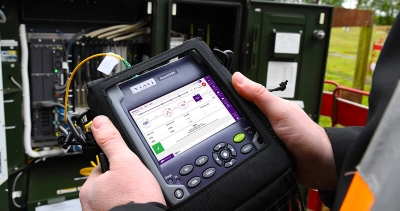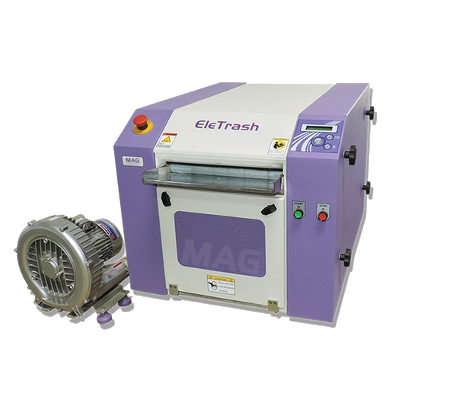Frequent problems solved by modern fibre testing equipment
Exploring the Impact of Robotic Vision on Modern Production Techniques and Quality Assurance
Robotic vision modern technology is transforming the landscape of modern manufacturing and quality assurance. By integrating advanced imaging systems and expert system, suppliers can attain unprecedented degrees of accuracy and efficiency. This shift not just optimizes manufacturing processes yet additionally addresses vital obstacles in preserving item criteria. As markets progressively depend on these advancements, the implications for future manufacturing methods stay to be fully explored. What will this suggest for the competitive characteristics of the market?
Recognizing Robotic Vision Innovation
Robotic vision technology functions as the foundation of automation in contemporary manufacturing. It encompasses using cameras, sensing units, and expert system to enable robots to analyze and reply to aesthetic information from their environment. This modern technology permits robots to determine, find, and assess items, making them with the ability of doing intricate jobs such as setting up, examination, and product handling with precision. The integration of device discovering formulas even more improves the capacity of robotic vision systems, allowing them to adjust to varying problems and boost with time. By refining photos and information in real-time, robot vision systems can assist in much faster decision-making and lower errors in manufacturing processes (optical fibre diameter analyser). This innovation not only enhances operational effectiveness yet also ensures that high quality standards are fulfilled continually. As the production landscape continues to develop, understanding the intricacies of robotic vision modern technology ends up being important for leveraging its potential fully
Benefits of Robotic Vision in Production
Robotic vision innovation offers substantial advantages in production by boosting precision and accuracy in jobs such as quality control and setting up. This enhanced level of information warranties that items satisfy rigid requirements, lowering waste and rework. In addition, the combination of robot vision can result in boosted production performance, permitting producers to enhance their processes and accomplish greater result rates.
Enhanced Precision and Accuracy
In contemporary production, enhanced precision and accuracy are crucial for optimizing manufacturing procedures and ensuring product high quality. Robotic vision systems enable equipments to do complex tasks with remarkable uniformity. These systems make use of innovative imaging innovations to spot minute details and variants in products, parts, and finished items. By examining visual information in real-time, robot vision considerably minimizes human mistake, resulting in less defects and greater top quality criteria. Furthermore, boosted accuracy in measurements and placing facilitates much better placement in assembly processes, which is crucial for elaborate styles. Ultimately, the integration of robot vision not only boosts the integrity of producing outcomes however also cultivates self-confidence amongst customers regarding item stability and performance. This precision is critical in sectors where quality is critical.
Boosted Production Effectiveness

Makers are significantly turning to vision systems to boost manufacturing performance across various procedures. These advanced systems allow real-time evaluation and tracking, significantly lowering downtime triggered by errors or problems. By incorporating robot vision, companies can automate quality control, enabling for faster recognition of issues and reducing the demand for human treatment. This causes structured operations, as robots can swiftly adapt to modifications in production demands without giving up accuracy. Moreover, vision systems promote far better supply management by precisely tracking elements and products, making certain suitable resource application. Eventually, the fostering of robot vision not just improves performance however also adds to greater outcome rates, decreased functional costs, and boosted general performance in the manufacturing field.
Enhancing Top Quality Control Processes
Robotic vision modern technology significantly enhances quality assurance procedures in production by utilizing precision examination methods. These advanced systems assist in real-time flaw discovery, making certain that items meet stringent high quality requirements. As a result, suppliers can minimize waste and improve general performance.
Precision Assessment Techniques
Precision evaluation strategies have actually transformed quality control processes in manufacturing, allowing the discovery of min problems that standard techniques may neglect. These strategies take advantage of progressed imaging technologies, such as high-resolution cams and laser scanning, to attain unparalleled precision. By utilizing robotic vision systems, producers can automate evaluation tasks, making certain consistent performance and lowering human mistake. The combination of artificial intelligence algorithms in addition enhances these systems, allowing them to adjust and enhance with time. On top of that, accuracy evaluation facilitates the recognition of subtle variations in product dimensions and surface finishes, which can significantly impact total item top quality. Consequently, producers can implement rehabilitative activities a lot more swiftly, ultimately resulting in decreased waste and improved client contentment.
Real-Time Defect Discovery
Harnessing sophisticated imaging modern technologies, real-time issue discovery changes top quality control processes in manufacturing. By integrating high-resolution cameras and sophisticated formulas, manufacturers can promptly identify anomalies throughout production. This technology promotes immediate rehabilitative activities, decreasing waste and improving general performance. Real-time systems examine products as they move along the production line, guaranteeing that defects are identified and resolved right away production routines. On top of that, the execution of artificial intelligence boosts the precision of these systems, allowing them to adjust to brand-new flaw patterns in time. Manufacturers benefit from enhanced product quality and decreased functional prices. Eventually, real-time flaw detection not only improves processes however likewise fosters a society of constant renovation in contemporary manufacturing settings.
Real-Time Information Evaluation and Decision Making
In the dynamic landscape of manufacturing, real-time data evaluation encourages systems to make swift, notified decisions. By leveraging sophisticated robotic click here for more info vision innovations, producers can collect and process vast quantities of information instantaneously. These systems examine visual inputs to check production procedures, making certain that any deviations from high quality requirements are detected and addressed without delay. Subsequently, producers can enhance operations by reallocating sources and adjusting operations his response based upon real-time insights.
In addition, the assimilation of data analytics enables predictive maintenance, where prospective tools failures are prepared for prior to they interrupt manufacturing. This aggressive approach decreases downtime and improves overall performance. optical fibre diameter analyser. The capacity to make data-driven choices in actual time substantially minimizes waste and boosts item top quality, permitting manufacturers to reply to market needs promptly. As a result, real-time data analysis not just streamlines production however likewise cultivates a society of continual improvement in modern-day production settings
Obstacles in Executing Robotic Vision Solutions
Carrying out robotic vision systems in making offers a variety of difficulties that can impede their effectiveness. One significant obstacle is the complexity of integrating these systems with existing equipment and operations. Makers typically encounter compatibility concerns with legacy tools, leading to increased expenses and downtime. Furthermore, the variability in product shapes, sizes, and products can complicate the calibration of vision systems, demanding considerable training and fine-tuning.
One more challenge lies in refining big volumes of aesthetic data in genuine time. High-performance computer sources are crucial, which may need additional financial investment in infrastructure. Furthermore, there is a scarcity of competent workers with the ability of handling and keeping these innovative systems, causing prospective functional ineffectiveness. Making certain the dependability and accuracy of robotic vision systems under differing ecological conditions positions a continuous obstacle. Attending to these problems is vital for maximizing the potential advantages of robotic vision in manufacturing.
Future Fads in Robotic Vision for Manufacturing
As improvements in expert system and artificial intelligence proceed to advance, the future of robot vision in production shows up increasingly promising. Arising fads indicate a shift in the direction of much more sophisticated imaging innovations, such as 3D vision systems and hyperspectral imaging, which will certainly boost precision in quality control processes. Integration with the Internet of Points (IoT) will allow real-time data analysis, enabling robot systems to adapt swiftly to modifications in the manufacturing setting. Moreover, the advancement of joint robots (cobots) outfitted with advanced vision abilities is anticipated to assist in seamless human-robot interactions, improving performance and security on the factory floor. Additionally, the consolidation of side computer will encourage robotic vision systems to refine data locally, lowering latency and making it possible for faster decision-making. These developments will certainly not only streamline manufacturing processes yet likewise substantially improve product quality, positioning robot vision as a foundation of future industrial procedures.
Often Asked Concerns
Just How Much Does Robotic Vision Modern Technology Commonly Price?
Robotic vision modern technology usually sets you back between $10,000 and $100,000, relying on the complexity and specs. Elements influencing rate include sensing unit top quality, software program capacities, and combination requirements, making it vital to evaluate certain job needs.
What Industries Are Many Affected by Robotic Vision Advancements?
Robotic vision innovations greatly effect industries such as production, auto, electronic devices, and food handling - useful content optical fibre diameter analyser. These markets profit from boosted automation, improved top quality control, and raised performance, leading to streamlined operations and lowered labor costs
Can Robotic Vision Solutions Be Integrated With Existing Machinery?
Robotic vision systems can indeed be incorporated with existing equipment. This integration boosts operational effectiveness, permitting manufacturers to utilize progressed modern technologies without the demand for full overhauls, therefore enhancing production processes and preserving quality standards.

What Skills Are Called For to Run Robotic Vision Solutions?
Operating robot vision systems requires effectiveness in programming, an understanding of machine discovering, understanding of image handling techniques, and the capacity to fix equipment and software concerns, making sure seamless integration and suitable performance within making environments.
Are There Any Kind Of Safety And Security Interest In Robotic Vision in Production?
